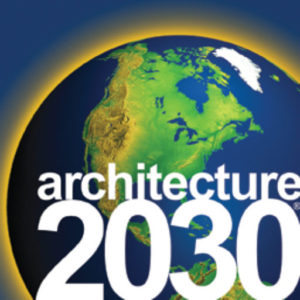What is Architecture 2030?
/in 2030 Challenge, Announcements/by arch2030
Architecture 2030 is a non-partisan, solution oriented research organization founded in response to the energy and climate change crisis in 2003 and formally established as a non-profit in 2006.”
Architecture 2030’s goal is to achieve dramatic and measurable reductions in the fossil fuel consumption and greenhouse gas (GHG) emissions of the Building Sector by transforming the way buildings and developments are planned, designed, constructed and operated.
Architecture 2030 (sometimes referred to simply as ‘2030’) revealed the true impact of buildings on climate change. Performing extensive research, 2030 discovered that the Building Sector is both the largest energy consumer (49%) and the largest contributor to GHG emissions (46%) in the U.S.
Architecture 2030 (sometimes referred to simply as ‘2030’) revealed the true impact of buildings on climate change. Performing extensive research, 2030 discovered that the Building Sector is both the largest energy consumer (49%) and the largest contributor to GHG emissions (46%) in the U.S.
This information, together with the timeline for CO2reductions mandated by the scientific community and the organization’s extensive knowledge and experience with buildings, led the organization to officially issue the ‘2030 Challenge’ in January of 2006. A global initiative, the 2030 Challenge calls for all new buildings and major renovations to reduce their fossil-fuel, GHG-emitting consumption by 60% today, 70% in 2015, 80% in 2020, 90% in 2025 and to reach carbon-neutrality (using no fossil-fuel, GHG-emitting energy to operate) by the year 2030.
From 2006 onward, 2030 has worked to educate and collaborate with key stakeholders to implement the 2030 Challenge at the local, state, and federal levels, as well as internationally. Through its website, research, publications, reports, keynotes and lectures, programs, events, diverse media outlets, and social networks, 2030 seeks to broaden adoption and implementation of the 2030 Challenge.
Now that you’ve gotten the long answer, why not visit our brand new website www.architecture2030.org if you’ve still got questions.
Industry Leaders Recognize Architecture 2030 Among Nation’s Most Effective Organizations
/in Announcements/by arch2030
e2 Design: Architecture 2030
/in Videos/by arch2030This episode, from season two of the acclaimed PBS series, explores 2030’s groundbreaking work. Aired December 2007. Narrated by Brad Pitt.
The CRE Solution
/in Research & Analysis/by arch2030Download the CRE Solution (.pdf)
•
Download Summary (.pdf)
Without swift intervention, the commercial real estate (CRE) crisis will cripple the economic recovery, raise unemployment, and lead to scores of small business and community bank failures. To avert this crisis, Architecture 2030 recommends that Congress implement the ‘CRE Solution’, providing a fully tradeable and transferable tax deduction tied to specific energy reduction targets that will create 1.3 million jobs while restoring credit capacity and liquidity in the CRE market.
The Problem
Commercial real estate (CRE) transactions have dropped a staggering 90 percent since 2007. Between now and 2014, $1.4 trillion in CRE loans will be coming due; half of these currently are underwater. Commercial property values have plummeted by more than 40 percent, and commercial vacancies continue to increase. In addition, the construction industry has lost over two million jobs leading to job losses in related sectors and further shrinking revenue to state and local governments. Construction unemployment now hovers at about 20 percent. The largest CRE loan losses are projected to begin in 2011 falling disproportionately on small businesses and smaller regional and community banks, many of which are FDIC insured and have high concentrations of CRE loans. Because these banks play a critical role in providing capital to small businesses and new business start-ups, their failure could undermine the economic recovery, leading to further unemployment and greater economic instability.
The CRE Solution
The CRE Solution is a 3-year, tax deduction program that encourages commercial property owners to complete substantive efficiency renovation projects. The deduction would be granted on the full value of qualifying efficiency improvements up to a maximum amount. It would be tradeable and fully transferable to a new owner for the life of the deduction. The CRE Solution would amend the Energy Efficient Commercial Building Tax Deduction (26 U.S.C. 179(d)) from $1.80 per sq.ft. to a range of $3.00 to $9.00 per sq.ft. for meeting energy reduction targets as follows:
| Existing Building Renovations | New Building Construction | ||||||||||||||||||||||||
|
|
||||||||||||||||||||||||
For each $6 billion of deferred CRE tax revenue, the CRE Solution would generate $70.8 billion in new private spending, and $15.4 billion in new federal tax revenue, more than paying for itself.
The CRE Solution Impact
- Creates 1.3 million jobs, quickly and cost-effectively,
- Increases after-tax cash flow and property values, and reduces loan defaults,
- Increases CRE desirability and investment value,
- Increases new CRE sales (narrows the gap between the bid
and ask price of CRE property), - Brings ESCo’s and A/E/C frims into the CRE market,
- Decreases building energy consumption, greenhouse gas emissions,
and operating costs, and - Generates billions of dollars in federal, state, and local tax revenue.
The CRE Solution and Jobs
The ‘CRE Solution’ commercial building tax deduction is designed to leverage deferred federal tax dollars to stimulate private spending for efficiency renovation and high-performance new construction. For each federal tax dollar deferred, building owners will spend, on average, $11.80 on commercial building renovation and new construction. It is this $70.8 billion in new private spending that creates 1.3 million jobs [1] for each $6 billion in deferred taxes. Additionally, the CRE Solution will generate $5 billion in state and local government revenue and $15.4 billion in new federal tax revenue, more than paying for itself. And, as CRE property is sold, the government receives the deferred taxes. Since the CRE market is now frozen with few transactions and little construction taking place, a tax deduction tied to efficiency construction will increase government revenue as CRE property is sold and renovated, and new buildings built.
Both the amount of tax deduction and deferred allocation is weighted toward building efficiency renovation rather than new construction. The maximum tax deduction for renovation ranges from $4.50 to $9.00 per sq.ft. for renovation and $3.00 to $7.50 per sq.ft. for new construction. For each $6 billion in deferred taxes, $4.8 billion is allocated for renovation and $1.2 billion for new building construction.
Download the CRE Solution (.pdf)
•
Download Summary (.pdf)
Architecture 2030 Ranked at Top
/in Uncategorized/by arch2030Industry Leaders Recognize Architecture 2030 Among Nation’s Most Effective Organizations.
The annual Design Futures Council “2010 Sustainable Design Survey” of 240 design industry leaders in the U.S. was released this month, ranking Architecture 2030 among the top three most effective organizations (USGBC, AIA, and Architecture 2030) advancing green building design and construction in the U.S. today.
The survey also rated Architecture 2030 first among industry leaders in ‘leadership and resource deployment’ to move sustainability issues forward in the U.S. and identified Edward Mazria, founder and CEO of Architecture 2030, as second among the nation’s leading ‘role models’ for green and sustainable design.

Industry leaders participating in the survey included architects (61%), engineers, landscape architects, interior designers, and planning and urban design professionals.
Such recognition by the architecture, planning, and design community is an indication of the ongoing success of Architecture 2030’s initiatives.
Transformation Underway
/in Uncategorized/by arch2030The 2030 Challenge is fundamentally changing the U.S. Building Sector.
 Seventy-three percent (73%) of the 30 largest Architecture / Engineering (A/E) firms, responsible for over $100 billion in construction annually, have now adopted and are implementing the 2030 Challenge. According to a recent poll of design industry leaders by the Design Futures Council, approximately forty percent (40%) of all U.S. architecture firms have adopted the Challenge.
Seventy-three percent (73%) of the 30 largest Architecture / Engineering (A/E) firms, responsible for over $100 billion in construction annually, have now adopted and are implementing the 2030 Challenge. According to a recent poll of design industry leaders by the Design Futures Council, approximately forty percent (40%) of all U.S. architecture firms have adopted the Challenge.
The adoption of the 2030 Challenge by large A/E firms has global implications. Since most of these firms are multinational, the shift towards building to the Challenge carries important economic implications, representing a significant, stable global market for high-performance building materials, products, and on-site renewable energy systems.
Over 100 Firms Commit to AIA Commitment

Over 100 architecture firms are participating in the ‘2030 Commitment‘, an initiative by the American Institute of Architects (AIA). These firms are tasked with developing energy models for all firm-designed projects and reporting to the AIA how each project’s predicted performance compares to the Architecture 2030 Challenge targets.
This initiative will result in an invaluable database of real buildings that meet/exceed the Challenge targets. This database will provide firms with a method for documenting what works, and sharing that information with other firms through the Commitment website.
In 2006, the AIA became the first organization to adopt the Architecture 2030 Challenge, followed soon after by the U.S. Conference of Mayors and USGBC, among others. Since then, the AIA has worked vigorously, through its state and local chapters to bring the Challenge to its membership. This dedication is an important example of the architecture profession’s commitment to Architecture 2030’s mission to transform the U.S. Building Sector.
ABOUT US
Architecture 2030’s mission is to rapidly transform the built environment from the major contributor of greenhouse gas emissions to a central solution to the climate crisis.



